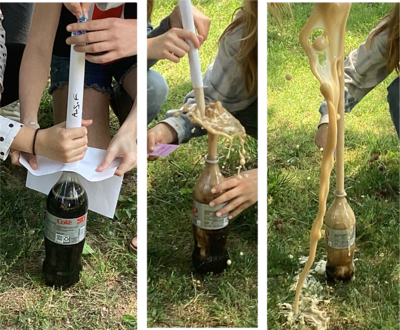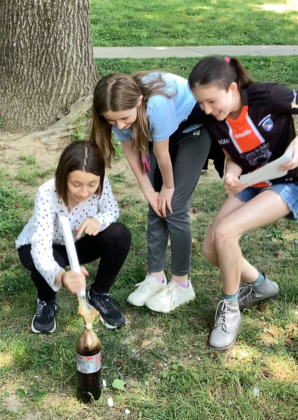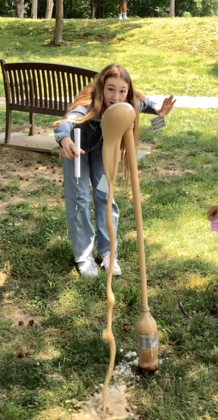Hands-on chemistry!

What does the Coke-Mentos experiment have to do with climate change and can milk dance? These were the questions that the students of the FuF - Natural Sciences course for the 5th and 6th grade dealt with. In the second half of the school year, the focus was on experiments with materials that can also be found in everyday life. Food starch, glue, milk and Coca-Cola, …, but also alginate or agar-agar from the molecular kitchen for edible food packaging - everything was used.
Everyone knows the Coke-Mentos experiment, but what does it have to do with climate change? Four teams took up the challenge of obtaining the highest Coke-Mentos geyser. After a first failed attempt, the four teams took a very close look at the execution and chemistry of the experiment. It turned out that a pack of Mentos had to get into a 1 L Diet Coke as quickly as possible. The idea of gluing the Mentos together and plopping them into the bottle proved to be unsuitable because the glued joints reduced the surface area of the Mentos, which had to be as large as possible for a high reaction rate and thus a high geyser (see photos), too much. The best way was a paper roll filled with Mentos and a card (a lunch pass is very good for this) or other piece of paper that can be quickly pulled away between the roll and the bottle. Also, warmed Coke turned out to work better than cold cola because carbon dioxide is less bound up in warm Coke, so it can be released faster and the Coke foams better. So, it's similar to the warming of the oceans - the warmer the water gets, the more carbon dioxide is released into the atmosphere.

The question how milk can "dance" can also be answered quite simply. If you pour some milk onto a flat plate, add a few drops of food coloring and dip a cotton swab with dishwashing soap into the milk, it will look as if the food coloring in the milk is dancing. The colors spread out in waves and twist into spirals. The surface tension and the fat in the milk prevent the colors from mixing with the milk. If the rinsing agent comes into contact with the milk, the tension of the milk surface is reduced, and the colors move as if by themselves and it looks a bit like the milk or the color in the milk is dancing.
If you feel like experimenting yourself, you can try these two experiments at home. It is a lot of fun!
The Natural Sciences FuFies











